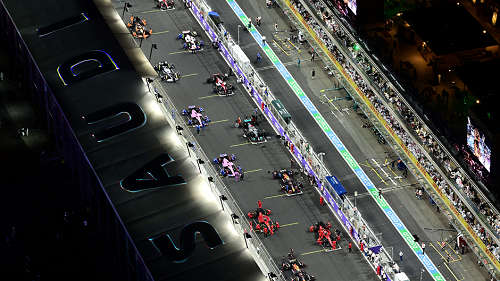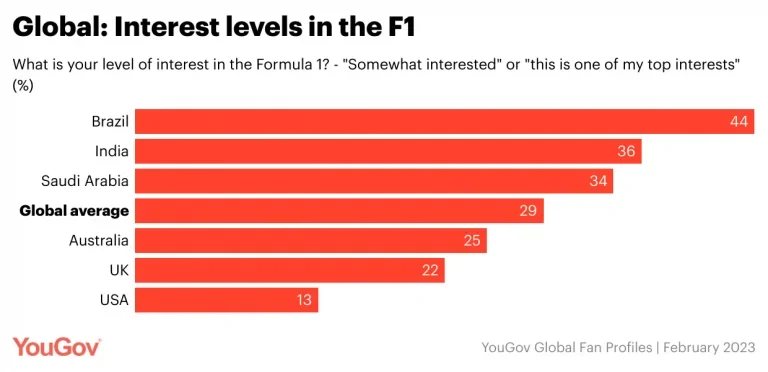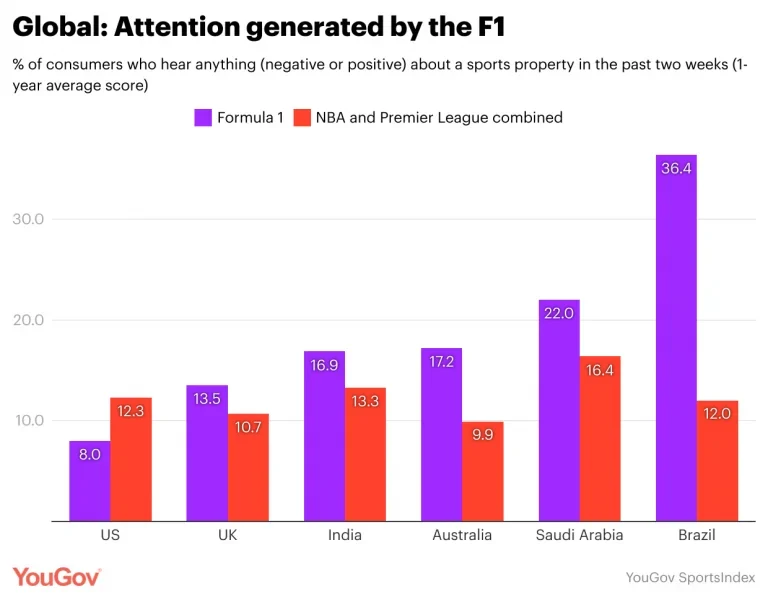
Formula 1 – An always-on global sports event
F1 is one of the few truly global sports properties with widespread public interest running annually.
The F1 season is in full throttle, with the Saudi Arabian Grand Prix and the Australian Grand Prix having concluded recently. We dive into data from YouGov Global Fan Profiles to understand the unique position of F1 as one of the truly global properties with annual operations.
Firstly, F1 is one of the most popular events across the world, with nearly three in ten consumers saying that they are either somewhat interested in the event or that it is one of their top interests. The only events ahead of it are ones that don’t occur less than annually – the Summer Olympics (49%), FIFA Football World Cup (46%) and the Winter Olympics (42%).
The spread of the popularity of F1 across the globe is quite even, although it’s popularity is particularly high in South America where two-fifths of consumers are interested in it (40%). Shares are also sizeable in MENA (32%), APAC (29%) and Europe (27%). Even in North America, a fifth of consumers are interested in F1 (19%).
While Global Fan Profiles captures data in over fifty different markets, in this piece we focus on six select markets – the UK, the US, Saudi Arabia, Australia, India and Brazil.

Of these markets, Brazil shows the strongest fan following for F1 (44%). But over a third of Indians (36%) and Saudi residents (34%) also express an interest in the event. A quarter of Australians (25%) and a slightly lower share of UK residents (22%) are also interested in it. In the US, where there is a strong culture around domestic motorsports such as the NASCAR and IndyCar among others, the share drops to well below the global average at 13%.
The advantage of having a long season across multiple markets is that F1 has an opportunity to keep fans engaged almost throughout the year. This reflects in its Attention scores, which measures the share of people who have heard about a sports property in the last two weeks, across various markets compared to other popular sports properties. For instance, In Australia, Formula 1’s Attention score is 17.2 over the last year, higher than the Wimbledon’s 13.0. This even though a significantly higher share of Australians are interested in the Wimbledon (37%) than in F1 (25%).
Even in the UK, Formula 1 (13.5) outdoes the Champions League (10.0) on Attention scores even though there are more people interested in the Champions League (26% vs 22%). What this means is that the format of F1 allows audiences to stay tuned for longer periods of time over the course of the year.
While Attention for these other types of sports properties peak around certain events, F1 is able to keep a hold of fan attention for more days, resulting in its Attention scores often surpassing those of leagues that might otherwise enjoy higher popularity.
To explore this tendency in more detail, we look at the average Attention score of Formula 1 in each of our markets over the past 12 months and compare it against the average Attention score of the (English) Premier League and NBA combined in each market. Why these competitions? Because the Premier League (29%) and NBA (28%) have an almost equal share of global consumers interested as Formula 1 (29%).

With the exception of the US, Formula 1 generated a higher Attention score on average over the last year than the NBA and Premier League combined. The difference is particularly sharp in Brazil, where F1 returned an Attention score of 36.4 compared to 12.0 for the other two leagues.
For brands seeking to advertise to a global audience, particularly with an emphasis on constant connection, partnering with F1 might just be a suitable option.
Explore our living data – for free
Want to run your own research? Run a survey now
Make smarter business decisions with better intelligence. Understand exactly what your audience is thinking by leveraging our panel of 20 million+ members. Speak with us today.